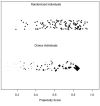Estimating the causal effect of randomization versus treatment preference in a doubly randomized preference trial
- PMID: 22563844
- PMCID: PMC3772621
- DOI: 10.1037/a0028031
Estimating the causal effect of randomization versus treatment preference in a doubly randomized preference trial
Abstract
Although randomized studies have high internal validity, generalizability of the estimated causal effect from randomized clinical trials to real-world clinical or educational practice may be limited. We consider the implication of randomized assignment to treatment, as compared with choice of preferred treatment as it occurs in real-world conditions. Compliance, engagement, or motivation may be better with a preferred treatment, and this can complicate the generalizability of results from randomized trials. The doubly randomized preference trial (DRPT) is a hybrid randomized and nonrandomized design that allows for estimation of the causal effect of randomization versus treatment preference. In the DRPT, individuals are first randomized to either randomized assignment or choice assignment. Those in the randomized assignment group are then randomized to treatment or control, and those in the choice group receive their preference of treatment versus control. Using the potential outcomes framework, we apply the algebra of conditional independence to show how the DRPT can be used to derive an unbiased estimate of the causal effect of randomization versus preference for each of the treatment and comparison conditions. Also, we show how these results can be implemented using full matching on the propensity score. The methodology is illustrated with a DRPT of introductory psychology students who were randomized to randomized assignment or preference of mathematics versus vocabulary training. We found a small to moderate benefit of preference versus randomization with respect to the mathematics outcome for those who received mathematics training.
(c) 2012 APA, all rights reserved
Figures
Similar articles
-
Design and analysis of partially randomized preference trials with propensity score stratification.Stat Methods Med Res. 2022 Aug;31(8):1515-1537. doi: 10.1177/09622802221095673. Epub 2022 Apr 26. Stat Methods Med Res. 2022. PMID: 35469503 Free PMC article.
-
Causal inference methods to assess safety upper bounds in randomized trials with noncompliance.Clin Trials. 2015 Jun;12(3):265-75. doi: 10.1177/1740774515572352. Epub 2015 Mar 1. Clin Trials. 2015. PMID: 25733675 Free PMC article.
-
Is Propensity Score Analysis a Valid Surrogate of Randomization for the Avoidance of Allocation Bias?Semin Liver Dis. 2017 Aug;37(3):275-286. doi: 10.1055/s-0037-1606213. Epub 2017 Aug 28. Semin Liver Dis. 2017. PMID: 28847037 Review. No abstract available.
-
The use of propensity scores and observational data to estimate randomized controlled trial generalizability bias.Stat Med. 2013 Sep 10;32(20):3552-68. doi: 10.1002/sim.5802. Epub 2013 Apr 1. Stat Med. 2013. PMID: 23553373 Free PMC article.
-
Effect of Treatment Preference in Randomized Controlled Trials: Systematic Review of the Literature and Meta-Analysis.Patient. 2019 Dec;12(6):593-609. doi: 10.1007/s40271-019-00379-6. Patient. 2019. PMID: 31372909
Cited by
-
A randomized preference trial to inform personalization of a parent training program implemented in community mental health clinics.Transl Behav Med. 2016 Mar;6(1):73-80. doi: 10.1007/s13142-015-0366-4. Transl Behav Med. 2016. PMID: 27012255 Free PMC article. Clinical Trial.
-
SMART Binary: New Sample Size Planning Resources for SMART Studies with Binary Outcome Measurements.Multivariate Behav Res. 2024 Jan-Feb;59(1):1-16. doi: 10.1080/00273171.2023.2229079. Epub 2023 Jul 17. Multivariate Behav Res. 2024. PMID: 37459401 Free PMC article.
-
Generalizability in the family-to-family education program randomized waitlist-control trial.Psychiatr Serv. 2013 Aug 1;64(8):754-63. doi: 10.1176/appi.ps.002912012. Psychiatr Serv. 2013. PMID: 23633161 Free PMC article.
-
Moving Toward a Precision-Based, Personalized Framework for Prevention Science: Introduction to the Special Issue.Prev Sci. 2019 Jan;20(1):1-9. doi: 10.1007/s11121-018-0955-9. Prev Sci. 2019. PMID: 30362085 Free PMC article.
-
Effectiveness of psychological treatments for depressive disorders in primary care: systematic review and meta-analysis.Ann Fam Med. 2015 Jan-Feb;13(1):56-68. doi: 10.1370/afm.1719. Ann Fam Med. 2015. PMID: 25583894 Free PMC article.
References
-
- Braslow JT, Duan N, Starks SL, Polo A, Bromley E, Wells KB. Generalizability of studies on mental health treatment and outcomes, 1981 to 1996. Psychiatric Services. 2005;56:1261–1268. doi: 10.1176/appi.ps.56.10.1261. - PubMed
-
- Cochran WG. The planning of observational studies of human populations. Journal of the Royal Statistical Society: Series A. General. 1965;128:234–266. doi:10.2307/2344179.
-
- Cook TD, Steiner PM. Case matching and the reduction of selection bias in quasi-experiments: The relative importance of the pretest as a covariate, of unreliable measurement, and of mode of data analysis. Psychological Methods. 2010;15:56–68. doi:10.1037/a0018536. - PubMed
-
- Coronary Artery Surgery Study (CASS) A randomized trial of coronary artery bypass surgery. Comparability of entry characteristics and survival in randomized patients and nonrandomized patients meeting randomization criteria. Journal of the American College of Cardiology. 1984;3:114–128. doi:10.1016/S0735-1097(84)80437-4. - PubMed



